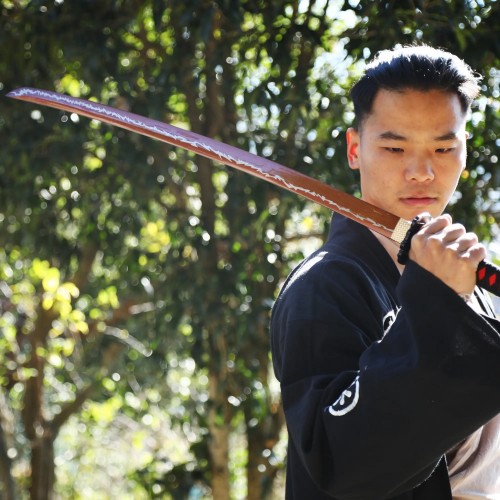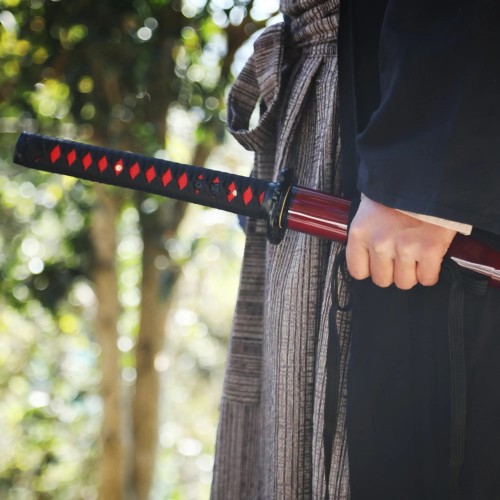The katana sword is one of the most iconic weapons in the world, known for its legendary craftsmanship, unique design, and formidable power. As the weapon of choice for samurai warriors in Japan, the katana has a rich history and cultural significance that has captivated people for centuries. In this blog post, we will explore the fascinating world of the katana sword, from its origins and evolution to its symbolism and spirituality, as well as its use in martial arts and collecting.

The katana sword is characterized by its long, curved blade, which is often around 60-73 cm in length. The blade is single-edged and sharpened on the side facing away from the wielder, allowing for powerful and efficient cutting motions. The katana also has a distinctive hamon, or temper line, which is created during the forging process and gives the blade its unique appearance. The handle, or tsuka, is typically made of wood and wrapped in silk or cotton cord, providing a comfortable and secure grip. The katana's balance and weight distribution are also carefully calibrated, with the center of gravity usually located near the point where the blade meets the handle. All of these features combine to make the katana an exceptionally well-designed and versatile weapon.
The katana sword originated in Japan in the 14th century and quickly became the weapon of choice for samurai warriors. Its design was influenced by earlier swords from China and Korea, but the katana had its own distinctive features, such as a curved blade, a long handle, and a sharp point for piercing armor. The katana became a symbol of the samurai code of honor, or bushido, and was often used in duels to the death.
The katana sword is a marvel of engineering and craftsmanship, with a complex design that has evolved over centuries. The blade is made of tamahagane, a type of steel that is smelted from iron sand and charcoal. The blade is then heated, hammered, and quenched to create a sharp edge and a resilient core. The handle, or tsuka, is wrapped in silk or leather and fitted with a guard, or tsuba, to protect the hand. The katana sword is known for its balance, flexibility, and durability, which make it a formidable weapon in the hands of a skilled warrior.
Using the katana sword requires years of training and discipline, as well as a deep understanding of its mechanics and techniques. Basic stances and movements include the tachi-ai, or starting position, the kiriage, or upward cut, and the kesagiri, or diagonal cut. Advanced techniques include the niten-ichi, or two-sword style, and the battoujutsu, or quick-draw technique. Training for the katana sword also involves mental preparation, such as meditation and visualization, to cultivate the warrior spirit.
The katana sword has a rich symbolism and spiritual significance in Japanese culture, representing honor, loyalty, and courage. The sword is often seen as a living entity with its own spirit, or kami, which is imbued by the swordsmith during the forging process. The katana sword is also associated with the Zen philosophy of mindfulness and self-discipline, as well as with the Shinto religion of nature worship and purification. The sword is often used in traditional Japanese ceremonies, such as weddings and funerals, to symbolize the passage of life and the continuity of the samurai spirit.

The katana sword has a rich history of use in both warfare and personal combat. Originally developed as a weapon for samurai warriors, the katana was used both for cutting down enemy soldiers and for dueling with other samurai. In addition to its martial uses, the katana also had cultural significance and was often given as a gift or used as a symbol of honor and status. Today, the katana is primarily used for martial arts training and demonstration, as well as for display and collection by enthusiasts around the world. Some martial arts styles, such as iaido and kendo, have specific techniques and training methods dedicated to the use of the katana. The katana's elegant design and rich history continue to fascinate people around the world, making it one of the most iconic and enduring symbols of Japanese culture.
Collecting katana swords is a popular hobby for enthusiasts around the world, but it requires knowledge and skill to acquire and maintain a quality collection. Factors such as age, provenance, and condition can affect the value and authenticity of a katana sword. Caring for a katana sword involves proper storage, cleaning, and maintenance, as well as periodic inspections by a qualified expert. Displaying a katana sword collection also requires attention to aesthetic and safety considerations, such as lighting, humidity, and security.
The katana sword is not just a weapon, but a symbol of Japan's rich cultural heritage and martial spirit. Its history, craftsmanship, and symbolism continue to inspire and captivate people around the world. Whether used for combat, collecting, or appreciation, the katana sword is a testament to the enduring legacy of the sam.